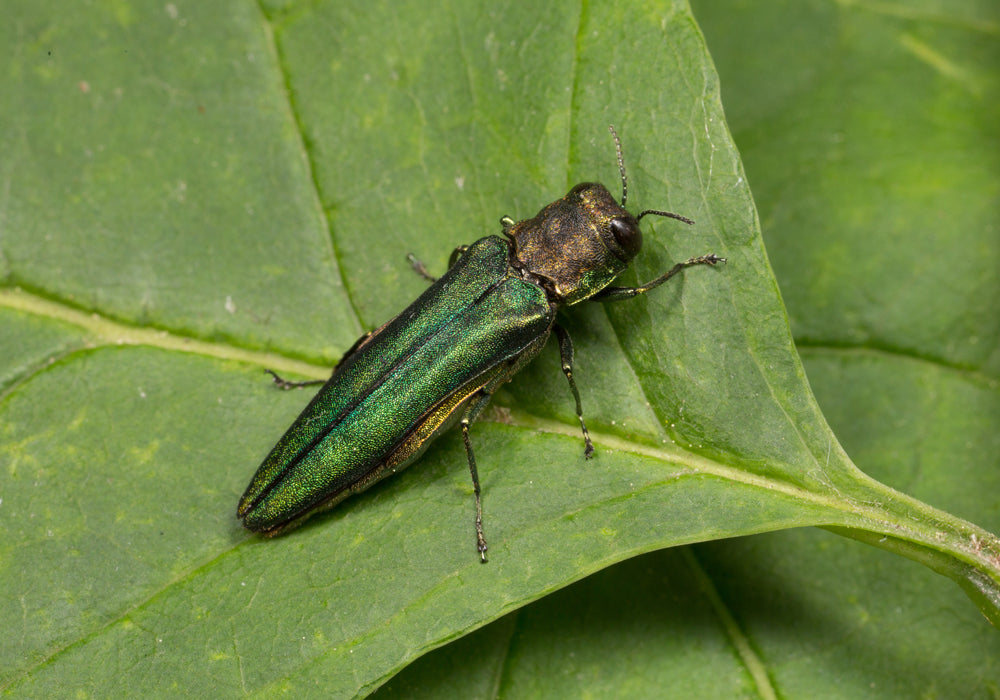Why monitor for invasive pests such as Emerald Ash Borer?
The accidental introduction of species which are not native to the UK poses a risk to both our production industries and conservation of our biodiversity. Species which are newly introduced to an area can upset the natural balance of an ecosystem; increasing competition, displacing native species and creating new problems for farming and forestry production. With increasing global trade, movement of goods and materials increases the risk of pests being transported. Additionally, climate change resulting in the UK having milder winters will likely result in more introduced species able to survive once arrived.
Why use pheromone traps?
It is impossible to examine every item imported for presence of potential invasive pests. Pheromone traps allow constant monitoring for the presence of a pest, with minimal labour input. Once setup, monitoring traps are left in situ and do not interfere with ongoing activities within the area. Pheromone lures used in traps are often specific to a certain insect species, only trapping the target species allows clear identification of whether a pest is present within an area.
A range of pheromone traps for monitoring invasive pests are available from Andermatt UK, including the aPhinity EAB trap for catching Emerald Ash Borer (EAB, Agrilus planipennis). The aPhinity EAB® trap is used widely across North America to monitor for adult Emerald Ash Borer (A. planipennis) beetles. Hung in Ash trees through the adult beetles flight period aPhinity EAB® traps are used to detect spread of Emerald Ash Borer across USA and Canada. As well as being hung from trees in risk areas, aPhinity EAB® traps can be used for monitoring at points of entry (of both harvested wood, Ash wood containing products and Ash plant material) where early detection is key to preventing its spread into and through the UK.
Benefits of using pheromone traps to detect Emerald Ash Borer (EAB):
• Traps are easy to setup, reliable and minimal maintenance.
• Emerald Ash Borer is a bark boring insect and so may go un-noticed as there are few external symptoms until the tree starts to die within 2 to 3 years of initial infestation.
• Early visible symptoms of Ash dieback caused by Emerald Ash Borer infestation could be mis-attributed to competition, stress or disease.
• Suitable for trapping highly mobile pests such as Emerald Ash Borer.
Why monitor for Emerald Ash Borer?
The Emerald Ash Borer (EAB, Agrilus planipennis) has become a highly destructive beetle in other countries where it has accidentally been introduced. Originally from Asia, this pest has been introduced to North America and Western Russia from where it has killed millions of Ash trees and is now spreading across these continents. With this increasing spread, the Emerald Ash Borer (Coleoptera: Buprestidae) poses a significant risk to the UK where, even with mitigations, it has been given a very high risk rating of 75 out of 125 (Feb 2019, for more information on UK risk rating for invasive species click here. Specifically to the ash trees (Fraxinus species) it infests and kills but also to wider biodiversity should Ash trees be killed.
The Forestry Commission have a contingency plan in place for the potential introduction of this invasive pest. A key part of any plan is accurate monitoring to determine the risk posed.
What is the aPhinity EAB® trap?
The aPhinity EAB® is an Emerald Ash Borer (A. planipennis) specific sticky trap which contains both a species-specific pheromone and a green-leaf host volatile to attract adult beetles. Studies have shown that combining both a (3z)-Lactone pheromone with Z3 Hexenol plant volatile increased the rates of Emerald Ash Borer detection (Ryall et. al., 2013). For more information and to buy aPhinity EAB trap click here.
How to use the aPhinity EAB® trap to detect Emerald Ash Borer?
The aPhinity EAB® pheromone trap is suitable for use in any situation where monitoring for Emerald Ash Borer (A. planipennis) is required. The trap consists of UV resistant green plastic coated in glue which is folded into a prism shape. The two separate sachets, one of pheromone lure and one of plant volatile, are hung within the trap. The green trap is then hung from a branch within the tree canopy through May, June and July. In the USA the flight period is from late May to early June lasting 3 to 6 weeks and it is expected to be similar in the UK. The attractants are designed to be released over a three-month period (at 20°C) to cover the expected adult flight period should Emerald Ash Borer be introduced into the UK.
Best practice for using insect monitoring traps:
• Store pheromone and plant volatile lures unopened in a cool location until use.
• Before placing in the trap, pierce the sachets above the marked line.
• Hang the trap in the top half of the tree canopy.
• Hang the trap from a branch at least 2.5cm diameter to reduce risk of breaking.
• Position the trap on the sunny side of the tree.
Benefits to the environment.
Quickly and correctly identifying the presence of an invasive pest species is key to any containment and management strategy. Emerald Ash Borer is an example of a pest which posed a very high risk to the UK should it be introduced and therefore vigilance is key. Monitoring however is a challenge due to larval stages hidden underneath the bar, very limited period of adult activity and highly mobile adult beetles able to disperse over wide areas.

